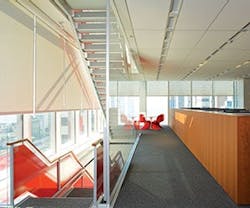Automated Shading Systems: Benefits and Advantages
Daylighting generates energy savings by limiting electrical lighting, but the increased solar energy can strain HVAC systems and sacrifice occupant comfort. Take advantage of automated shading systems, and you and your occupants will be walking on sunshine.
Installing a successful shading and control system depends on several characteristics, from glaring brightness and heat transfer to building location and solar orientation. Let the following factors guide your decision.
Where To Begin
Start by considering your lighting and HVAC loads, advises Jan Berman, president of manufacturer MechoSystems. Occupant complaints can be a telling element.
However, certain situations make shading systems particularly attractive. “Some older buildings added dark film to exterior glass to kill the heat gain, and as the film needs replacing, building owners want a facelift. Instead of putting on another film or replacing the glass, integrate a shading system,” Berman says.
“If you’re struggling to show that your building can compete with newer ones, consider automated shading,” he adds. “It’s a highly visible, technical amenity that not every building has.”
Consult experts to specify a shading system and incorporate it into your existing management system, recommends Rich Ries, business unit manager of window coverings for manufacturer Hunter Douglas Contract.
“There are a lot of dynamics to piece together and meet your requirements,” he says. “Determine what’s possible and what you want to accomplish. Set your expectations.”
System Specifications
An automated shading system integrates with existing building controls and responds to changing conditions in order to maximize performance.
“Select a system that is an exceptional overall solution,” Ries says. “Throw light deep into the room with light shelves, have the view-through and heat-reflecting qualities of shading fabric, and utilize a responsive operating system.”
The headquarters of The New York Times occupies floors 2-27 of a 52-story tower in downtown New York City. To maximize natural light, connect occupants with the outdoors, and intercept solar energy, the facilities staff employed a MechoSystems automated shading strategy.
The system includes predictive and responsive controls based on solar tracking, brightness, and heat gain, among others.
It also offers data logging, remote access, and reporting. Over 1,000 motors were installed across more than 500 zones.
Operating independently of the lighting control system, the shading system maximizes the amount of daylight let in comfortably, and the electric lighting reacts accordingly.
The building’s average annual lighting load is 0.38W per square foot, according to facilities data. The ASHRAE/IES 90.1-2010 requirement for office buildings is 0.90.
The system also allows for manual override, but after being installed for nearly five years, post-occupancy studies reveal the shades operate in automatic mode about 95% of the time, highlighting user satisfaction.
Occupant Comfort
The two important factors impacting comfort are preventing veiling glare and keeping people out of the sun while actively letting sunlight in, Berman explains.
“It would be nice to have cake without calories, but that doesn’t exist,” he adds. “You can have too much of a good thing, whether that’s brightness or heat.”
Allowing for manual overrides is perhaps the best way to ensure comfort is a primary concern.
“Comfort and energy savings go hand in glove. Most people think of those ideas in contrast, and that to be more comfortable you need to make the room cooler,” says Berman. “We can achieve both and have a win-win.”
Just as shading integrates into your larger building management system, you should combine goals of cost savings with occupant satisfaction.
“Your thought process should be governed by energy efficiencies and the environment of your workers,” suggests Ries. “That way, you can create something that is very beneficial overall for both the building as well as its occupants.”
Chris Curtland [email protected] is assistant editor of BUILDINGS.
